Internet of Poultry - Fully automated chicken shed
-
@breimann , door mechanism and end-of-run contacts
I did a few attempt to make the door arm out of wood, but wasn't happy with any of them. The biggest problem was to connect the arm to the motor. I usually use the below cable connectors to fasten something to a shaft, but the shaft of the motor is 6mm diam while the biggest connector I can find can only take a 5mm shaft.
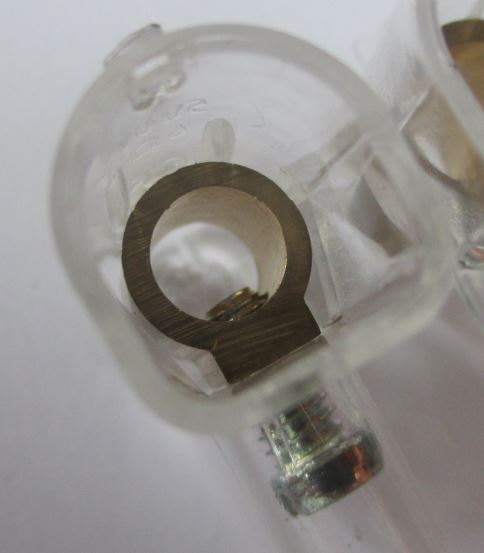
In the end I bought two steel corner pieces in the closest DIY shop and adapted them with a drill and a grinder.
In the same DIY shop I found a cheap router which was fastened to a 6mm drill with a small inbus screw, the router is the black piece in the below photos.
After some attempts to glue to router to the corner piece, I decided to solder them together with plumbing solder. If you attempt this, be carefull not to burn your fingers. I takes a few minutes to cool down.
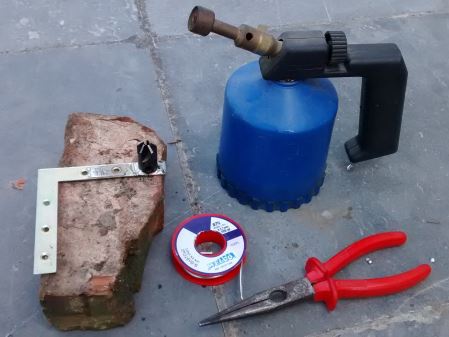

The end result, when mounted in the shed looks like this
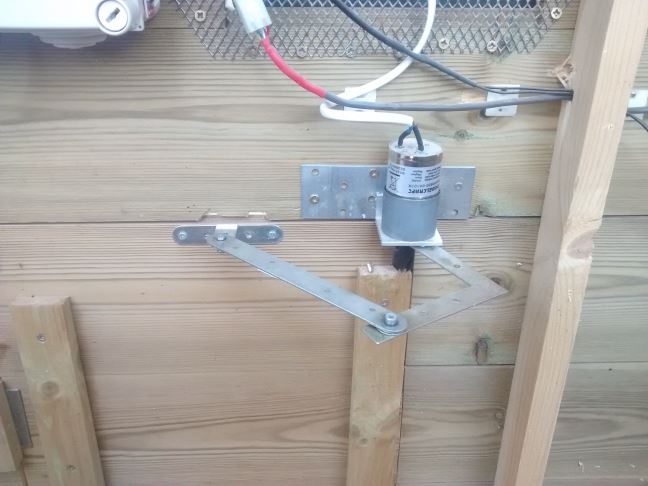
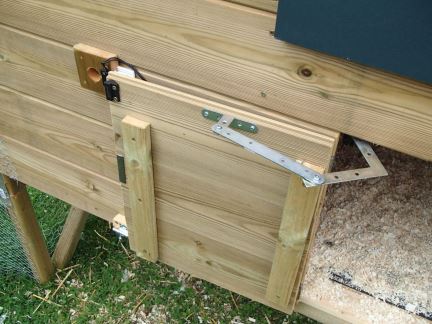
Here is a video of the door in action
0_1472754055923_Video deurtje.mp4In the pictures and the video you can see the end-of-run magnetic switches which I use to detect the open and close position of the door. These are connected to Arduino input pins.
@stefaanv
Door mechanism and end of run contacts
This is great info!
A couple questions.- Are you just using standard door hinges x 2 on the door on the outside?
- Is that a magnetic latch you have once it closes to stop a chook accidentally (or deliberately?? ;)) pushing against it?
- Did you buy the motor with the tube to fit inside it and bracket or did you fashion that yourself?
Thankyou!
-
@breimann , Battery and solar panels
I'm using a Seeeduino instead of an Arduino because it is more flexible. The (measured) power consumption is about 45mA @ 12V. Since I wanted to bridge a 10day holiday period securely (assuming no input from the solar panels), I selected a 10Ah (240h x 45mA = 10800mAh) Sealed Lead Acid battery from dynoeurope.
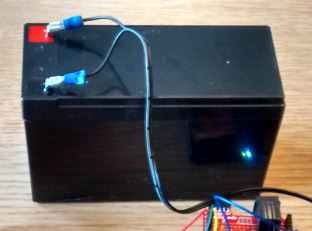
For the solar panels, I chose two 1.35 Wp 9V 150mA panels. 2x9V=18V >14.1V which is typically used to charge a 12V lead acid battery.
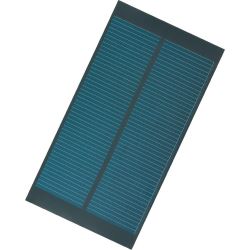
At first, I just connected the 2 panels in series across the battery and the arduino. This turned out to be a really bad idea ! The system stopped working when the battery was depleted to 4.5V. This wrecked the battery so I had to buy a new one.
Together with the new battery, I bought a Steca Solsum 6.6 F Solar charger (12V 6A) which provides over- and undervoltage protection. It also provides a suitable charging voltage for lead acid batteries.
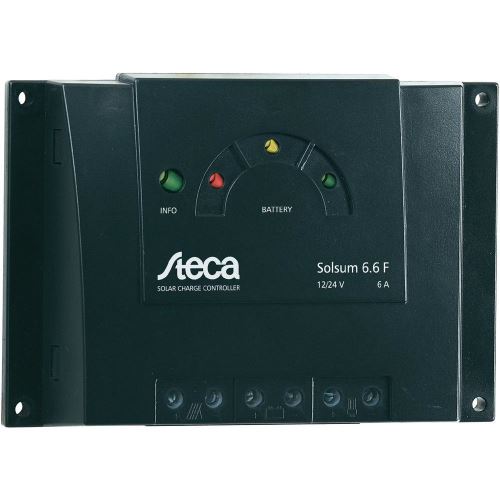
To be able to track the battery level, I attached an INA219 DC current sensor directly to the battery (it is supposed to be connected to the solar panel). It connects to the Seeeduino over i²c and measures current and voltage of the battery.

This allows me to get nice graphs of the energy production and consumption in the system. Beware that due to an error in Domoticz, negative currents are shown as positive in the charts.Voltage charts
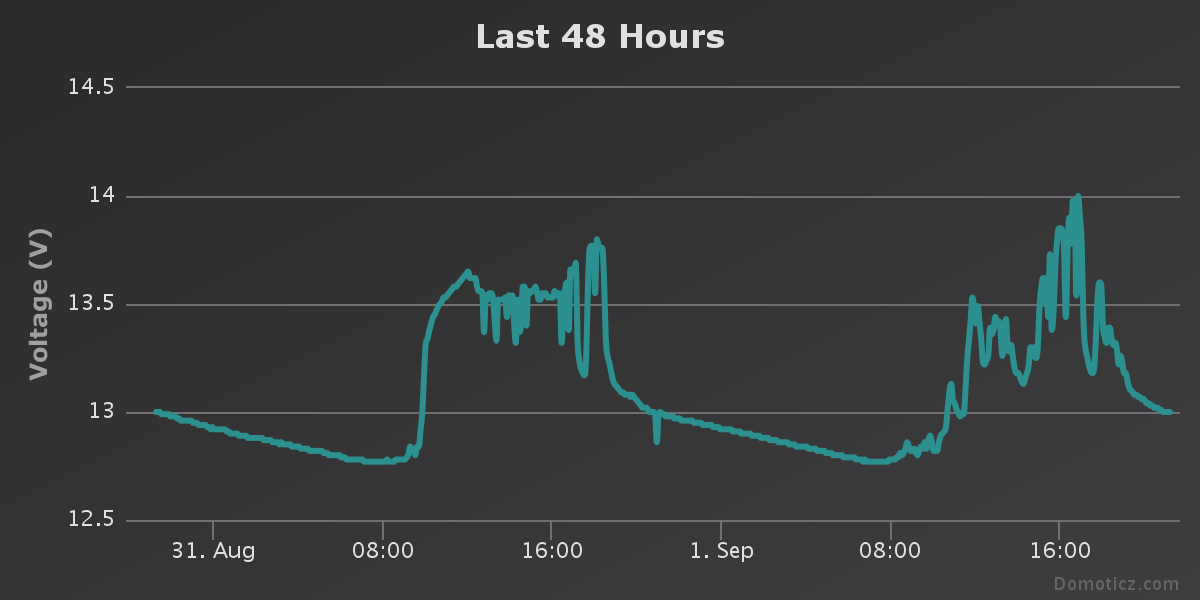
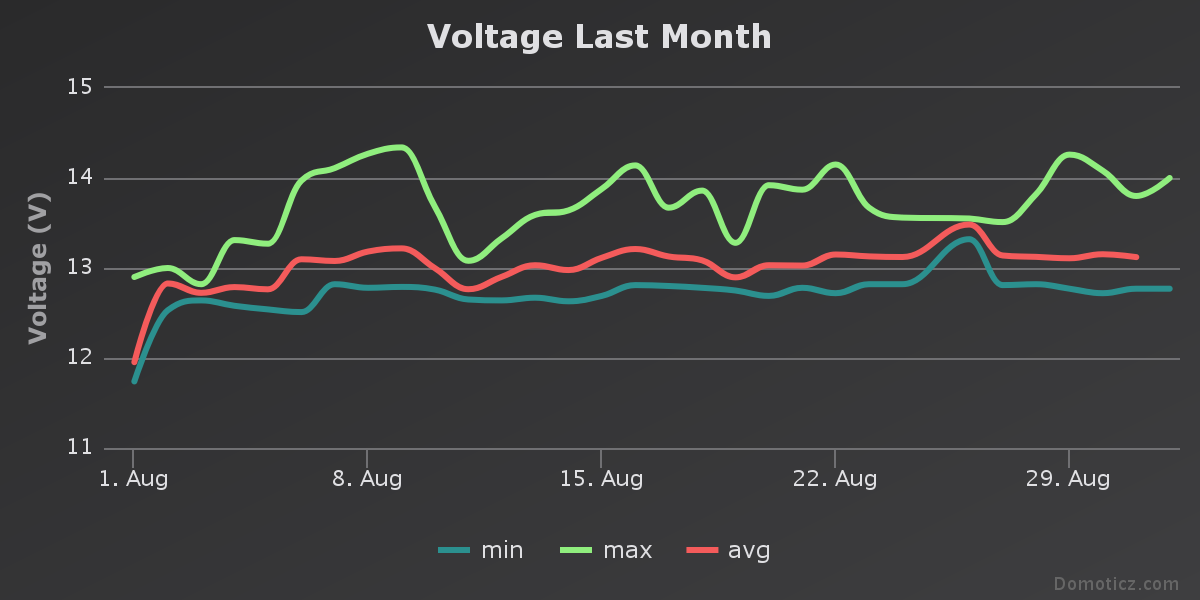
Current chart
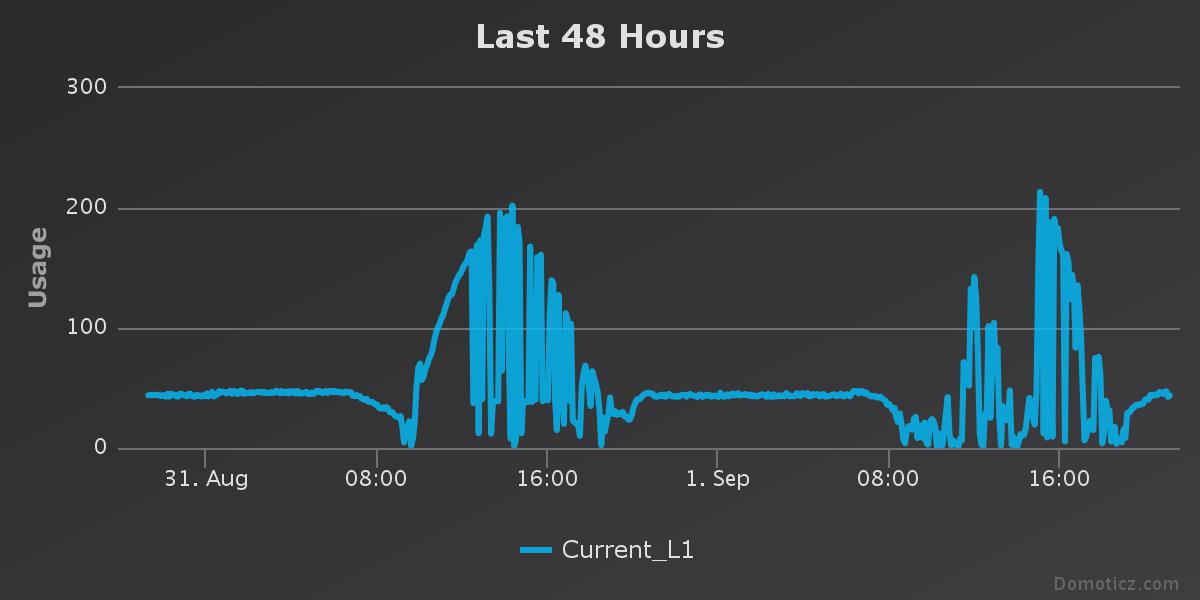
After some time, I decided to double the amount of solar panels.
When I connected the four panels in series I saw no difference at all in the charts.
When however, I connected the 4 panels 2 in series and 2 groups in parallel I found the produced current was doubled. After some investigation I understand that the Steca charger simple cuts the excess voltage of the panels to protect the battery but doesn't convert the energy in an efficient way. What I really need is an MPPT (Maximum Power Point Tracking) charger.
These however cost a small fortune, so in the name of matrimonial peace keeping, I decided to leave it like it is :-) -
@stefaanv
Door mechanism and end of run contacts
This is great info!
A couple questions.- Are you just using standard door hinges x 2 on the door on the outside?
- Is that a magnetic latch you have once it closes to stop a chook accidentally (or deliberately?? ;)) pushing against it?
- Did you buy the motor with the tube to fit inside it and bracket or did you fashion that yourself?
Thankyou!
@breimann
1/ Yes, 2 standard hinges. There's plenty of different types (big, small, different materials, ...) in DIY shops. One thing to consider is if you want the open or closed type. buy the open type if you want to remove the door, else the closed type. The open type comes in left and right types. Make sure to buy the right ones or your door will fall off the hinges :-)
2/ There is a chicken crushing protection in the software : if the "door closed" end-of-run isn't read within 4 seconds after the door started closing, then it will fully open again. The end-of-run switches are primarily to stop the motor when the end position is reached. Unlike with a servo or a stepper motor, with a DC motor you don't know at which position the door is. Also the motor is really strong. If it run too far something will break (I assume the internal gears will break first).
3/ I bought the holding bracket for the motor together with the motor. I found it to be really expensive and badly designed but you can't make everything yourself. (matrimonial peace keeping, remember ;-) ) -
@stefaanv
Solar Panel and Batteries
I'm all for matrimonial peace keeping!!
I'm just curious, why did you connect the INA219 DC current sensor directly to the battery and not the solar panel?@breimann
I figured that if I connect the INA to the solar panels, I only get info about energy generation, not about consumption.
By connecting it to the battery, I get both info's + the battery voltage which is a good indication for the charging level. What I can't see is the solar voltage and the absolute consumption and generation number (I measure the difference). However, there is physical evidence that it get's dark at night at which time the panels don't generate energy. The consumption is 45mA flat unless the camera or the LED's are switched on. So I can deduce all the information I'm not measuring.
Ideally you should install 2 or even 3 INA's to measure generation, consumption and battery separately, but I found it was better to spend the money elsewhere. -
@stefaanv
Solar Panel and Batteries
I'm all for matrimonial peace keeping!!
I'm just curious, why did you connect the INA219 DC current sensor directly to the battery and not the solar panel?@breimann
Just for fun, here is one of the evening recordings that is automatically stored on my Synology NAS every day. It provides evidence that the chickens were inside when the door closed. These recordings help me to set the correct ambient light level at which the door closes.
0_1472800935919_Evening take.mp4
It took some tuning, but this works really well now. The only times the chicks are not indoor when the door closes is on hot days when the temperature inside is still high in the evening. -
@stefaanv
Door mechanism and end of run contacts
This is great info!
A couple questions.- Are you just using standard door hinges x 2 on the door on the outside?
- Is that a magnetic latch you have once it closes to stop a chook accidentally (or deliberately?? ;)) pushing against it?
- Did you buy the motor with the tube to fit inside it and bracket or did you fashion that yourself?
Thankyou!
-
@breimann
By the way, in what part of the world in a chicken called a chook ? Austalia according to Google Translate ? Correct ? -
@breimann
By the way, in what part of the world in a chicken called a chook ? Austalia according to Google Translate ? Correct ? -
@breimann
Just for fun, here is one of the evening recordings that is automatically stored on my Synology NAS every day. It provides evidence that the chickens were inside when the door closed. These recordings help me to set the correct ambient light level at which the door closes.
0_1472800935919_Evening take.mp4
It took some tuning, but this works really well now. The only times the chicks are not indoor when the door closes is on hot days when the temperature inside is still high in the evening.@stefaanv
Love this recording. I love how you linked the recording to start 5 seconds before the door closes, and how you can see if there are eggs in your laying boxes and if the chooks are roosting!! Love it. Great thinking. What sort of camera are you using? -
@stefaanv
Love this recording. I love how you linked the recording to start 5 seconds before the door closes, and how you can see if there are eggs in your laying boxes and if the chooks are roosting!! Love it. Great thinking. What sort of camera are you using?@breimann
I'm using a cheap indoor dlink camera DCS-933L with night vision. One disadvantage : it can only be powered at 5V so I had to insert a DC/DC converter and it uses a lot of power (up to 200mA). So I only have it powered on about 1 minute every day. Just long enough for the NAS to pick up the signal and take a small clip.Great to have someone from the other side of the world interested in my project !!!
Now I'm really curious, since you walk upside-down compared to us, Do chook in Austalia sleep on top of the roost or do they hang heads-down from the roost ? :-) -
@breimann
I'm using a cheap indoor dlink camera DCS-933L with night vision. One disadvantage : it can only be powered at 5V so I had to insert a DC/DC converter and it uses a lot of power (up to 200mA). So I only have it powered on about 1 minute every day. Just long enough for the NAS to pick up the signal and take a small clip.Great to have someone from the other side of the world interested in my project !!!
Now I'm really curious, since you walk upside-down compared to us, Do chook in Austalia sleep on top of the roost or do they hang heads-down from the roost ? :-)@stefaanv
That's helpful re type of camera.
To shed light on your question re how chooks sleep on roosts in Australia... yes they do sleep upside down, a bit like a bat... but maybe bats don't sleep hanging upside down where you live?? ;)
No, gravity unfortunately (fortunately) hasn't taken a holiday here, so if they tried sleeping upside down i'm afraid their blood would all drain to their brains!! -
@bjacobse
OK, in Dutch a "kok" is a chef in a restaurant. However, they typically behave like male chickens, so that is not so far off. -
@stefaanv
That's helpful re type of camera.
To shed light on your question re how chooks sleep on roosts in Australia... yes they do sleep upside down, a bit like a bat... but maybe bats don't sleep hanging upside down where you live?? ;)
No, gravity unfortunately (fortunately) hasn't taken a holiday here, so if they tried sleeping upside down i'm afraid their blood would all drain to their brains!!@breimann
Here's the pictures of the cleaning. If you make a sliding bottom, do use mechanical sliders (I only have L-profiles) like the ones that are used in kitchen furniture. That way you'll be able to fully extend and your don't have to support the front. Do take care that the whole shed doesn't tip over.

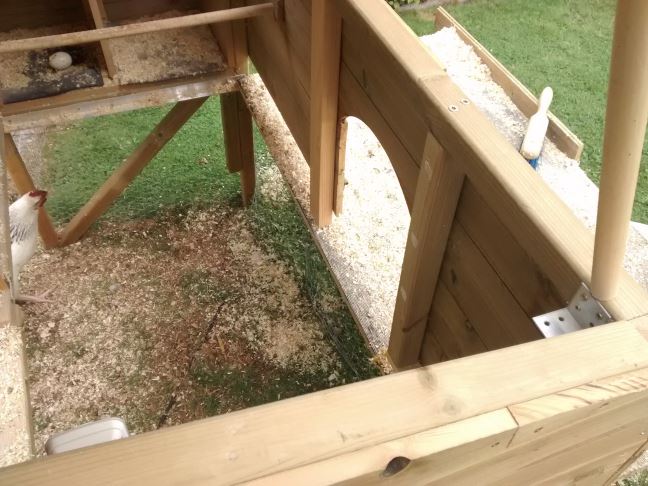
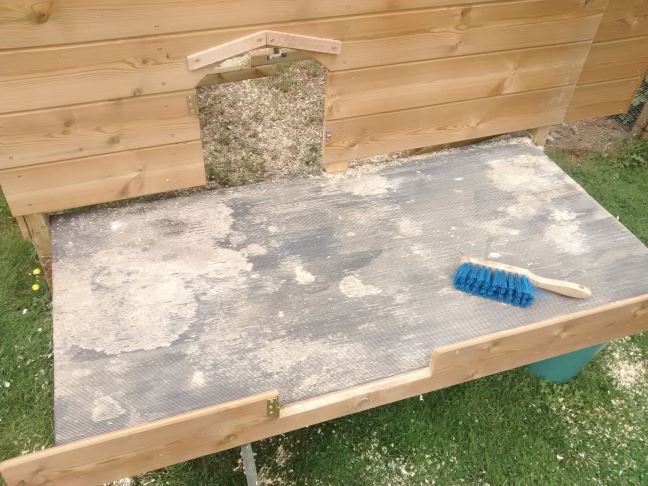
-
@breimann
Here's the pictures of the cleaning. If you make a sliding bottom, do use mechanical sliders (I only have L-profiles) like the ones that are used in kitchen furniture. That way you'll be able to fully extend and your don't have to support the front. Do take care that the whole shed doesn't tip over.



-
May I ask, how do you get debug remotely? I also presume you're using the MYS bootloader?
Great project!
-
May I ask, how do you get debug remotely? I also presume you're using the MYS bootloader?
Great project!
@Mark-Swift
Nope, that's what the Fritz.box router is for. It has remote USB which I usb for the debugging. It's not ideal (always fails after computer hibernation) but it does the trick. -
I would love to see your sensor code. I am in the process building an automated door for my coop as well.
-
I would love to see your sensor code. I am in the process building an automated door for my coop as well.
@Nathan-Overley
Hi Nathan, it's not nice code, been written too quickly. I have to rewrite it some day. Still, here it is, it may give you idea's. Let me know if you improve it.
0_1477377889434_Kippenhok_3.ino -
@stefaanv
Thank you! I will definitely post my version when I get it done. I really appreciate you posting the code!
